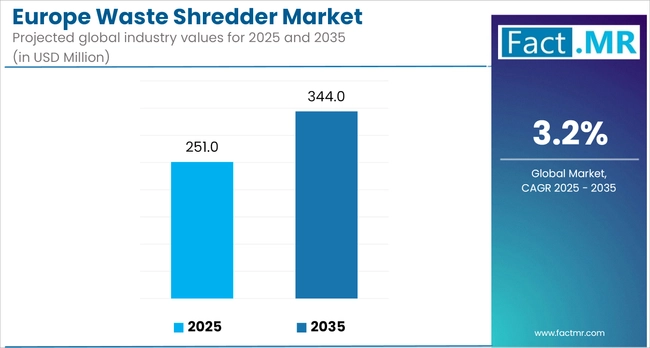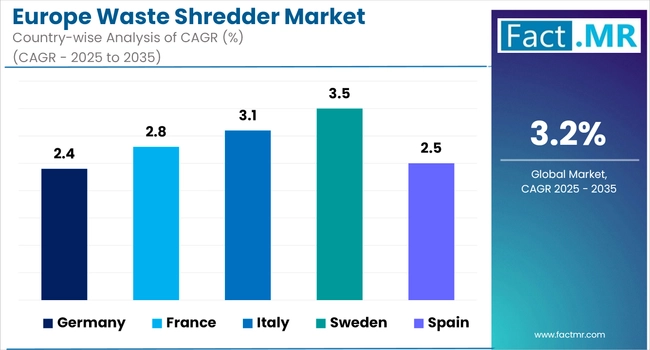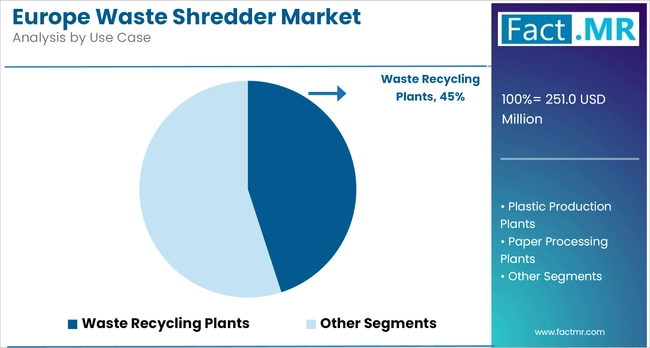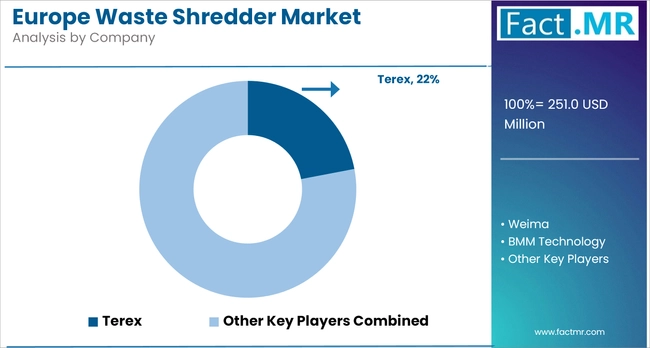Europe Waste Shredder Market
Europe Waste Shredder Market Analysis, By Shredding Speed, By Use Case, and Countries - Market Insights 2025 to 2035
Analysis of Europe Waste Shredder Market Covering 30+ Countries Including Analysis of US, Canada, UK, Germany, France, Nordics, GCC countries, Japan, Korea and many more.
Europe Waste Shredder Market Outlook (2025 to 2035)
The Europe waste shredder market is projected to increase from USD 251.4 million in 2025 to USD 344.5 million by 2035, with an annual growth rate of 3.2%, driven by the increasing demand for effective waste management solutions across industries, including manufacturing, recycling, and municipal services.
Stricter environmental regulations and an increasing focus on sustainability are key factors driving industries to adopt more advanced shredding technologies.

For instance, the European Union’s commitment to waste reduction and enhanced recycling efforts has led to the introduction of policies such as Extended Producer Responsibility (EPR), which encourages companies to take greater responsibility for the lifecycle of their products. Therefore, there is a rising need for shredders capable of handling a wide range of materials, from plastics to metals, with higher efficiency and precision. This shift towards more sustainable practices has made shredding equipment crucial for meeting recycling targets and reducing waste, fueling market demand.
What are the Drivers of the Europe Waste Shredder Market?
The European waste shredder market is experiencing robust growth, fueled by a combination of factors. Stricter environmental regulations, particularly those from the European Union, are prompting industries to adopt more efficient waste management practices to meet recycling targets and reduce their environmental impact. In addition, a growing focus on sustainability throughout the region is driving demand for technologies that enable the circular economy, where materials are recycled and reused, reducing the need for raw material extraction.
Technological advancements in energy-efficient systems and automated shredders are enhancing market demand by improving both operational efficiency and processing capabilities. The increasing emphasis on recycling, particularly in sectors such as plastics, metals, and municipal waste, has further contributed to the adoption of shredders. These machines help reduce waste volume and make it easier to sort and process materials for reuse in production cycles.
As Europe continues to industrialize and urbanize, the volume of waste generated is rising, further amplifying the need for effective waste management solutions. The transition to a circular economy model, where products are designed for reuse and recycling, is accelerating the adoption of shredders in various industries.
Additionally, municipalities and businesses are increasingly using shredders to reduce disposal costs, improve recycling rates, and achieve sustainability goals. These factors collectively position the European waste shredder market for continued expansion and innovation in the years ahead.
What are the Country Trends of the Europe Waste Shredder Market?
Regional differences influence the European waste shredder market in policies, industrial activity, and environmental goals across various countries. Germany leads the way, due to its strong recycling infrastructure and strict environmental regulations. The country’s industrial base, particularly in automotive manufacturing and heavy industry, creates a high demand for shredders, especially for processing metals and recycling electronic waste. Germany's dedication to a circular economy and sustainability drives further adoption of shredding technologies, solidifying its position as a market leader.
France follows closely behind, where increasing urbanization has spurred demand for more efficient waste management solutions. Government initiatives focused on recycling and waste reduction are accelerating the adoption of shredders in both municipal and industrial waste processing. The French market stands out for its commitment to sustainable practices and innovative approaches to waste management and recycling.
In Italy, steady growth in the waste shredder market is largely due to expanding recycling efforts and the need for efficient processing of both industrial and municipal waste. Italy’s growing focus on sustainability and circular economic principles is further promoting the use of advanced shredding technologies to meet these goals.
The United Kingdom also plays a key role in the European waste shredder market. With a strong push towards sustainable waste management practices, the UK is incentivizing the use of modern shredding technologies, particularly in sectors such as electronics, metals, and municipal waste. Regulatory frameworks are supporting this shift, helping the market expand.
In Eastern Europe, countries like Poland and the Czech Republic are seeing emerging growth in the market, driven by specific challenges such as tire disposal and the need for more efficient waste management systems. As these countries face increasing demands for waste processing, the adoption of advanced tire shredders and recycling equipment is on the rise.
Overall, while Germany and France remain dominant players, Italy, the UK, and countries in Eastern Europe are contributing to the market's expansion. Their growth is driven by regional industrial needs and local regulatory support aimed at improving recycling rates and sustainability practices.
What are the Challenges and Restraining Factors of Europe Waste Shredder Market?
The Europe waste shredder market faces a variety of challenges that could affect its growth and development. One of the primary hurdles is the high initial investment needed for advanced shredding technologies. This can be a barrier for smaller businesses or municipalities with limited budgets. In addition to the upfront costs, operational and maintenance expenses such as regular upkeep, repairs, and part replacements can put a strain on resources, especially for older shredders.
Stricter environmental regulations, particularly those related to noise, emissions, and safety, add to the complexity. These regulations can increase manufacturing costs and make compliance more challenging for companies. Another pressing issue is the shortage of skilled workers to operate and maintain these machines, especially in regions that lack specialized training programs.
The market is also highly fragmented, with numerous small and medium-sized players competing for market share. This intense competition makes it difficult for companies to differentiate themselves and maintain healthy profit margins. Additionally, some areas, particularly in Eastern Europe, face limited recycling infrastructure, hindering the widespread adoption of advanced shredders. The lack of necessary facilities in certain regions further complicates the efficiency of waste processing and recycling efforts.
Environmental concerns surrounding the disposal of non-recyclable shredded materials are another challenge. The rising costs of raw materials, such as steel and alloys, also contribute to increasing production costs and tighter profit margins for manufacturers. Moreover, integrating new technologies into existing systems can be both costly and time-consuming, particularly for businesses that lack the financial capacity to stay current with ongoing innovations.
These factors, when combined, make market growth more complex, necessitating strategic investments in technology, workforce development, and the alignment of regulatory practices to ensure continued progress in the industry.
Country-wise Outlook
Germany Waste Shredder Market Sees Growth Driven by Its Robust Recycling Infrastructure and Stringent Environmental Regulations

Germany's waste shredder market is experiencing strong growth, primarily driven by its well-established recycling infrastructure and stringent environmental regulations. The country has built one of the advanced waste management systems in Europe, supported by a comprehensive network of recycling facilities and a focus on material recovery. This robust infrastructure facilitates the widespread adoption of waste shredders, which play a crucial role in reducing waste volumes and enabling the recycling of materials such as plastics, metals, and paper.
Germany's commitment to sustainability is further strengthened by its stringent environmental laws, which impose high recycling targets and aim to reduce landfill dependency. For instance, under the European Union's revised waste legislation, Germany, along with other EU countries, is required to meet ambitious recycling goals by 2025 and beyond. These regulations are driving the demand for advanced shredding technologies as industries and municipalities seek solutions to meet national and EU recycling requirements.
Given its strong infrastructure, commitment to sustainability, and adherence to strict regulations, Germany is well-positioned for continued growth in the waste shredder market. The country’s ongoing investments in recycling infrastructure and sustainable waste management practices ensure that it will remain a dominant player in Europe’s waste processing industry.
France Increasing Urbanization Driving the Demand for Efficient Waste Management Solutions.
France’s waste shredder market is experiencing growth due to increasing urbanization, which leads to higher waste volumes and creates a need for more efficient waste management solutions. As urban areas expand, there is a growing demand for advanced waste processing technologies to handle the rising waste load.
The French government has implemented strict regulations, including the Anti-Waste and Circular Economy Law, which aims to reduce waste production and promote recycling nationwide. These regulations have encouraged widespread adoption of waste shredders to meet recycling targets and reduce landfill dependency.
Technological advancements in shredding technology have also contributed to improving the efficiency of waste management. Innovations have made it easier to recycle materials such as plastics, metals, and paper, further boosting the demand for shredders. Additionally, France’s strong commitment to sustainability, combined with the shift towards a circular economy, is creating more opportunities for shredding technologies to play a key role in waste reduction and material recovery.
The growth in urbanization, along with evolving regulations and technological progress, has made waste shredders essential to France’s strategy for sustainable waste management.
Italy Expanding Recycling Operations
Italy is making strides in expanding its recycling operations to manage increasing waste volumes and further its sustainability goals. This growth is evident through a range of strategic initiatives and investments nationwide.
In 2025, Lindner, an Austrian recycling technology company, partnered with Cesaro Mac Import to introduce the Merak 2800, a versatile single-shaft shredder, into the Italian market. This collaboration aims to enhance Italy's plastic recycling capabilities, aligning with a broader trend of adopting advanced shredding technologies to improve material recovery processes.
Similarly, Ambiente Italia in Acerra has boosted its recycling capacity by incorporating M&J F320 shredders into its operations. These high-capacity shredders are designed to process a range of waste types, including light household waste and oversized plastics, improving the quality of refuse-derived fuel (RDF) used in cement kilns.
In addition to these advancements, the Italian government is actively supporting the expansion of recycling efforts through regulatory frameworks and targeted investments. For instance, Italy is on track to meet the 2025 recycling targets for packaging and municipal waste, having already achieved recycling rates of 71% for packaging and 53% for municipal waste in 2022. However, additional efforts will be required to increase recycling rates further and reduce reliance on landfills to meet future targets.
These developments demonstrate Italy's commitment to strengthening its recycling operations through a combination of technological innovation, strategic partnerships, and supportive government policies. These initiatives are crucial for improving waste management efficiency and advancing the country's circular economy.
Category-wise Analysis
Medium-speed shredder to Exhibit Leading Share Among Shredding Speed
Medium-speed shredders are projected to maintain a dominant share in the European waste shredder market, driven by their versatility and efficiency in processing a wide range of materials. These shredders operate at speeds that balance throughput and energy consumption, making them suitable for various applications, including municipal solid waste, commercial and industrial waste, and biomass processing.
The preference for medium-speed shredders is evident in their widespread adoption across Europe. For instance, the Terex TDS V20 medium-speed shredder is designed to handle a diverse range of materials, including wood, green waste, and refuse-derived fuel (RDF), providing flexibility in waste processing operations. Its ability to produce a controlled product size in one pass is beneficial for operators, saving both time and fuel.
Moreover, medium-speed shredders are increasingly integrated into recycling lines to streamline operations and improve material recovery rates. Their design allows for the efficient processing of mixed waste streams, facilitating the separation and recovery of valuable materials. The incorporation of smart technologies into these shredders enhances operational efficiency and predictive maintenance capabilities, aligning with global sustainability goals.
In summary, the dominance of medium-speed shredders in the European market is attributed to their operational efficiency, versatility, and adaptability to various waste streams. Their continued adoption is expected to play a crucial role in advancing Europe's waste management and recycling efforts.
Waste recycling plants to Hold Leading Share in Europe Waste Shredder Market

In the European waste shredder market, waste recycling plants are projected to maintain a dominant share, driven by the increasing emphasis on sustainable waste management practices and stringent environmental regulations.
The European Union's Circular Economy Action Plan, along with various national policies, has set ambitious recycling targets, compelling industries and municipalities to adopt advanced waste processing technologies. Waste recycling plants play a crucial role in this ecosystem by efficiently processing mixed waste streams, reducing landfill dependency, and recovering valuable materials for reuse.
Technological advancements in shredder design have further enhanced the capabilities of recycling plants. Modern shredders offer improved energy efficiency, higher throughput, and the ability to handle a diverse range of materials, including plastics, metals, and organic waste. These innovations enable recycling facilities to meet the increasing demand for processed materials in various industries, including manufacturing, construction, and energy production.
Additionally, the integration of smart technologies, such as automation and data analytics, into shredding operations has optimized performance and reduced operational costs. These advancements align with the broader trend towards digitalization in the waste management industry, enhancing the efficiency and sustainability of recycling processes.
In summary, waste recycling plants are set to continue leading the European waste shredder market, supported by regulatory frameworks, technological innovations, and a collective commitment to a circular economy.
Competitive Analysis

Key players in the European waste shredder industry include Terex, Weima, BMM Technology, and UNTHA. These companies are at the forefront of providing advanced shredding solutions tailored to various waste management needs.
Terex offers a comprehensive range of shredders, including the TDS-V20SE, designed for medium-speed shredding applications. Their equipment is known for durability and efficiency, catering to industries such as construction and demolition, wood processing, and waste-to-energy sectors.
Weima specializes in industrial shredders suitable for plastics, wood, paper, and waste-to-energy applications. With a strong presence in Europe, Weima's machines are recognized for their robust design and versatility in handling a wide range of materials.
BMM Technology specializes in advanced shredding technologies, offering customized solutions for complex waste streams. Their equipment is designed to meet the specific requirements of different industries, ensuring efficient waste processing.
UNTHA is renowned for its innovative shredding systems that emphasize energy efficiency and minimal maintenance. With a global presence, UNTHA's shredders are widely used in applications ranging from municipal solid waste processing to recycling and the production of alternative fuels.
These companies play a pivotal role in shaping the European waste shredder market, offering solutions that enhance recycling efficiency and support sustainable waste management practices.
Recent Development
- In June 2025, UNTHA unveiled its new RS series of four-shaft shredders, which offer enhanced efficiency, increased throughput, and improved user-friendliness. The company also opened a Technology Innovation Center in Kuchl, Austria, to foster research and development, prototype testing, and collaboration with external partners, underscoring its commitment to innovation in waste shredding technology.
- In May 2024, BMH Technology entered the shredder market with the introduction of its TYRANNOSAURUS series. These shredders and crushers are designed for various applications, including the processing of municipal solid waste and the production of alternative fuels, reflecting BMH's expansion into the waste management sector.
Segmentation of the Europe Waste Shredder Market
-
By Shredding Speed :
- Slow Speed Shredders
- Medium Speed Shredders
- High-Speed Shredders
-
By Use Case :
- Waste Recycling Plants
- Plastic Production Plants
- Paper Processing Plants
- Metal Processing Plants
- Others
-
By Countries :
- Germany
- France
- UK
- BENELUX
- NORDIC
- Italy
- Spain
- Rest of Europe
Table of Content
- Executive Summary
- Industry Introduction, including Taxonomy and Market Definition
- Trends and Success Factors, including Macro-economic Factors, Market Dynamics, and Recent Industry Developments
- Market Demand Analysis 2020 to 2024 and Forecast 2025 to 2035, including Historical Analysis and Future Projections
- Market Analysis 2020 to 2024 and Forecast 2025 to 2035
- Shredding Speed
- Use Case
- Market Analysis 2020 to 2024 and Forecast 2025 to 2035, By Shredding Speed
- Slow Speed Shredders
- Medium Speed Shredders
- High-Speed Shredders
- Market Analysis 2020 to 2024 and Forecast 2025 to 2035, By Use Case
- Waste Recycling Plants
- Plastic Production Plants
- Paper Processing Plants
- Metal Processing Plants
- Others
- Market Analysis 2020 to 2024 and Forecast 2025 to 2035, By Region
- Germany
- France
- UK
- BENELUX
- NORDIC
- Italy
- Spain
- Rest of Europe
- Germany Sales Analysis 2020 to 2024 and Forecast 2025 to 2035, by Key Segments and Countries
- France Sales Analysis 2020 to 2024 and Forecast 2025 to 2035, by Key Segments and Countries
- UK Sales Analysis 2020 to 2024 and Forecast 2025 to 2035, by Key Segments and Countries
- BENELUX Sales Analysis 2020 to 2024 and Forecast 2025 to 2035, by Key Segments and Countries
- NORDIC Sales Analysis 2020 to 2024 and Forecast 2025 to 2035, by Key Segments and Countries
- Italy Sales Analysis 2020 to 2024 and Forecast 2025 to 2035, by Key Segments and Countries
- Spain Sales Analysis 2020 to 2024 and Forecast 2025 to 2035, by Key Segments and Countries
- Rest of Europe Sales Analysis 2020 to 2024 and Forecast 2025 to 2035, by Key Segments and Countries
- Sales Forecast to 2035 by Shredding Speed and Use Case for 30 Countries
- Competitive Assessment, Company Share Analysis by Key Players, and Competition Dashboard
- Company Profile
- Terex
- Weima
- BMM Technology
- UNTHA
List Of Table
- Table 1: Market Units Forecast by Region, 2020 to 2035
- Table 2: Market Units Forecast by Shredding Speed, 2020 to 2035
- Table 3: Market Units Forecast by Use Case, 2020 to 2035
- Table 4: Germany Market Units Forecast by Country, 2020 to 2035
- Table 5: Germany Market Units Forecast by Shredding Speed, 2020 to 2035
- Table 6: Germany Market Units Forecast by Use Case, 2020 to 2035
- Table 7: France Market Units Forecast by Country, 2020 to 2035
- Table 8: France Market Units Forecast by Shredding Speed, 2020 to 2035
- Table 9: France Market Units Forecast by Use Case, 2020 to 2035
- Table 10: UK Market Units Forecast by Country, 2020 to 2035
- Table 11: UK Market Units Forecast by Shredding Speed, 2020 to 2035
- Table 12: UK Market Units Forecast by Use Case, 2020 to 2035
- Table 13: BENELUX Market Units Forecast by Country, 2020 to 2035
- Table 14: BENELUX Market Units Forecast by Shredding Speed, 2020 to 2035
- Table 15: BENELUX Market Units Forecast by Use Case, 2020 to 2035
- Table 16: NORDIC Market Units Forecast by Country, 2020 to 2035
- Table 17: NORDIC Market Units Forecast by Shredding Speed, 2020 to 2035
- Table 18: NORDIC Market Units Forecast by Use Case, 2020 to 2035
- Table 19: Italy Market Units Forecast by Country, 2020 to 2035
- Table 20: Italy Market Units Forecast by Shredding Speed, 2020 to 2035
- Table 21: Italy Market Units Forecast by Use Case, 2020 to 2035
- Table 22: Spain Market Units Forecast by Country, 2020 to 2035
- Table 23: Spain Market Units Forecast by Shredding Speed, 2020 to 2035
- Table 24: Spain Market Units Forecast by Use Case, 2020 to 2035
- Table 25: Rest of Market Units Forecast by Country, 2020 to 2035
- Table 26: Rest of Market Units Forecast by Shredding Speed, 2020 to 2035
- Table 27: Rest of Market Units Forecast by Use Case, 2020 to 2035
List Of Figures
- Figure 1: Market Value Share (%), Growth Rate (Y-o-Y), and Units Projection by Shredding Speed, 2020 to 2035
- Figure 2: Market Value Share (%), Growth Rate (Y-o-Y), and Units Projection by Use Case, 2020 to 2035
- Figure 3: Market Value Share (%), Growth Rate (Y-o-Y), and Units Projection by Region, 2020 to 2035
- Figure 4: Germany Market Value Share (%), Growth Rate (Y-o-Y), and Units Projection by Shredding Speed, 2020 to 2035
- Figure 5: Germany Market Value Share (%), Growth Rate (Y-o-Y), and Units Projection by Use Case, 2020 to 2035
- Figure 6: Germany Market Value Share (%), Growth Rate (Y-o-Y), and Units Projection by Country, 2020 to 2035
- Figure 7: France Market Value Share (%), Growth Rate (Y-o-Y), and Units Projection by Shredding Speed, 2020 to 2035
- Figure 8: France Market Value Share (%), Growth Rate (Y-o-Y), and Units Projection by Use Case, 2020 to 2035
- Figure 9: France Market Value Share (%), Growth Rate (Y-o-Y), and Units Projection by Country, 2020 to 2035
- Figure 10: UK Market Value Share (%), Growth Rate (Y-o-Y), and Units Projection by Shredding Speed, 2020 to 2035
- Figure 11: UK Market Value Share (%), Growth Rate (Y-o-Y), and Units Projection by Use Case, 2020 to 2035
- Figure 12: UK Market Value Share (%), Growth Rate (Y-o-Y), and Units Projection by Country, 2020 to 2035
- Figure 13: BENELUX Market Value Share (%), Growth Rate (Y-o-Y), and Units Projection by Shredding Speed, 2020 to 2035
- Figure 14: BENELUX Market Value Share (%), Growth Rate (Y-o-Y), and Units Projection by Use Case, 2020 to 2035
- Figure 15: BENELUX Market Value Share (%), Growth Rate (Y-o-Y), and Units Projection by Country, 2020 to 2035
- Figure 16: NORDIC Market Value Share (%), Growth Rate (Y-o-Y), and Units Projection by Shredding Speed, 2020 to 2035
- Figure 17: NORDIC Market Value Share (%), Growth Rate (Y-o-Y), and Units Projection by Use Case, 2020 to 2035
- Figure 18: NORDIC Market Value Share (%), Growth Rate (Y-o-Y), and Units Projection by Country, 2020 to 2035
- Figure 19: Italy Market Value Share (%), Growth Rate (Y-o-Y), and Units Projection by Shredding Speed, 2020 to 2035
- Figure 20: Italy Market Value Share (%), Growth Rate (Y-o-Y), and Units Projection by Use Case, 2020 to 2035
- Figure 21: Italy Market Value Share (%), Growth Rate (Y-o-Y), and Units Projection by Country, 2020 to 2035
- Figure 22: Spain Market Value Share (%), Growth Rate (Y-o-Y), and Units Projection by Shredding Speed, 2020 to 2035
- Figure 23: Spain Market Value Share (%), Growth Rate (Y-o-Y), and Units Projection by Use Case, 2020 to 2035
- Figure 24: Spain Market Value Share (%), Growth Rate (Y-o-Y), and Units Projection by Country, 2020 to 2035
- Figure 25: Rest of Market Value Share (%), Growth Rate (Y-o-Y), and Units Projection by Shredding Speed, 2020 to 2035
- Figure 26: Rest of Market Value Share (%), Growth Rate (Y-o-Y), and Units Projection by Use Case, 2020 to 2035
- Figure 27: Rest of Market Value Share (%), Growth Rate (Y-o-Y), and Units Projection by Country, 2020 to 2035
- FAQs -
What is the Europe Waste Shredder Market Size in 2025?
The Europe Waste Shredder market is valued at USD 251.4 million in 2025.
Who are the Major Players Operating in the Europe Waste Shredder Market?
Prominent players in the Europe Waste Shredder market include Terex, Weima, BMM Technology, and others.
What is the Estimated Valuation of the Europe Waste Shredder Market by 2035?
The Europe Waste Shredder market is expected to reach a valuation of USD 344.5 million by 2035.
What Value CAGR Did the Europe Waste Shredder Market Exhibit over the Last Five Years?
The historic growth rate of the Europe Waste Shredder market was 2.8% from 2020 to 2024.